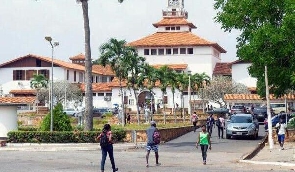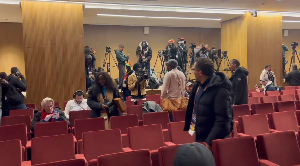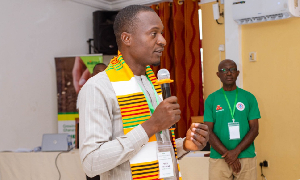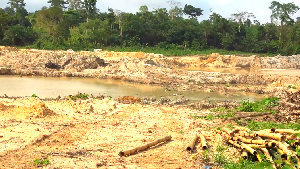“…If you take Western North most of the farms that we have established over the years have all been affected by galamsey and illegal mining. Western North aline over five thousand hectares of land under cocoa cultivation have been destroyed by illegal mining.”
The words of Dr Emmanuel Agyemang Dwomfour, Deputy Chief Executive Officer in-Charge of Agronomy and Quality Control at COCOBOD, when he made the horrendous revelation on Day-Two of the National Dialogue on Small Scale mining held between April 14 and 15 2021.
Bibiani-Anhwiaso-Bekwai municipality is one of the hubs of cocoa production but it is fast losing its grips in the production of the cash crop. Illegal mining is now a common phenomenon and perniciously growing into a mainstay for some communities, hitherto, thrive on cocoa.
Cocoa lands are currently,competing with illegal concessions and for the forest reserves they have lost their virginity.
Chine is a farming community with indigenes predominant cocoa farmers, however, illegal mining known as galamsey has taken over most farms. Over 20 hectares of cocoa farms sacrificed for illegal mining.
The few surviving trees have pods of the cash crop ‘dead on hanging’ apparently, they could not stand the dangerous chemicals these miners infuse into the land.
Dangerous chemicals like Mercury is very common among these illegal miners but, dangerous to water bodies and the environment.


“Mercury pollution is very common among miners as they burn the amalgam, which releases smoke and the miners are the first casualties as they have direct contact with the smoke.
The mine tailings also find its way into nearby water bodies, and if it finds its way into rivers, lakes or streams then it can pollute the water several kilometers from its source”-Augustine Boateng (Effect of small scale mining on the environment in Ghana, 2018).
Indigenes of Chine fear river Ankobrah whose tributary lies through the town may have been polluted by these miners, and they averred most of them are Chinese nationals “they have destroyed the Chine river which serves as source of water, now we have to travel miles in search of water.
Our cocoa farms have also been destroyed by these Chinese miners, nobody is talking about it” an apparent livid Ernestina Amprofi, a resident told Evans-Nkum.
To further deepen their displeasure, they wore red armband and demonstrated against illegal mining.
Perhaps, what is even more disturbing was a revelation from one resident at Merewa “they have heavily built armed men guarding their concessions and they are very aggressive.
They can maim or at worst kill.” Farms close to some of the concessions are taken because owners cannot access for fear of being attacked by hoodlums.
A local assembly member, Kwame Asamoah who has on several occasion launch campaigns against illegal mining in parts of the Western North is seen as a threat, but has not reneged “they are destroying our lands and even some people in authority are backing this illegality” he asserted.
Interestingly, the Bibiani forestry commission says they have not given license to any miner to enter the forest belts.
Only last week a two-day national consultative dialogue on small scale mining was held, which was opened by the president of the Republic.
A communique which was issued further outlawed illegal mining, surprisingly, the talks have only been reduced to rhetoric on the ground.















